
The River Tyne is a river in North East England. Its length is 73 miles (118 km). It is formed by the North Tyne and the South Tyne, which converge at Warden Rock near Hexham in Northumberland at a place dubbed 'The Meeting of the Waters'.
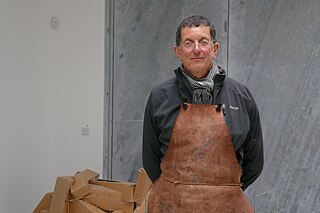
Sir Antony Mark David Gormley is a British sculptor. His works include the Angel of the North, a public sculpture in Gateshead in the north of England, commissioned in 1994 and erected in February 1998; Another Place on Crosby Beach near Liverpool; and Event Horizon, a multipart site installation which premiered in London in 2007, then subsequently in Madison Square in New York City (2010), São Paulo, Brazil (2012), and Hong Kong (2015–16).
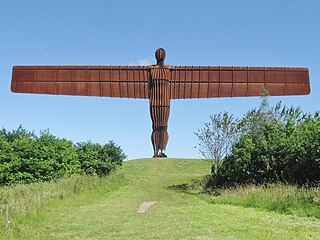
The Metropolitan Borough of Gateshead is a metropolitan borough in the metropolitan county of Tyne and Wear, England. It includes Gateshead, Rowlands Gill, Whickham, Blaydon, Ryton, Felling, Birtley, Pelaw, Dunston and Low Fell. The borough forms part of the Tyneside conurbation, centred on Newcastle upon Tyne. At the 2021 census, the borough had a population of 196,154.

B of the Bang was a sculpture by Thomas Heatherwick next to the City of Manchester Stadium in Manchester, England, United Kingdom, which was commissioned to mark the 2002 Commonwealth Games; at 56 metres (184 ft) it was one of the tallest structures in Manchester and the tallest sculpture in the UK until the completion of Aspire in 2008. The sculpture took its name from a quotation of British sprinter Linford Christie, in which he said that he started his races not merely at the "bang" of the starting pistol, but at "the B of the Bang".

Birtley is a town in the Metropolitan Borough of Gateshead, in Tyne and Wear, England. It is situated to the south of Gateshead and is conjoined to Chester-le-Street across the county boundary in County Durham.
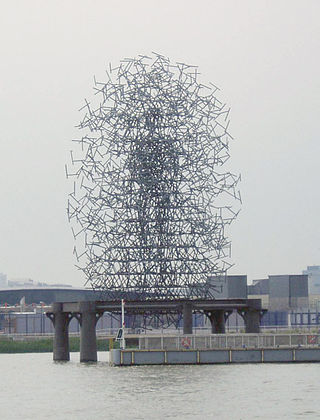
The Quantum Cloud is a contemporary sculpture, designed by Antony Gormley, located next to The O2 in London. The sculpture was commissioned for the site and was completed in 1999.
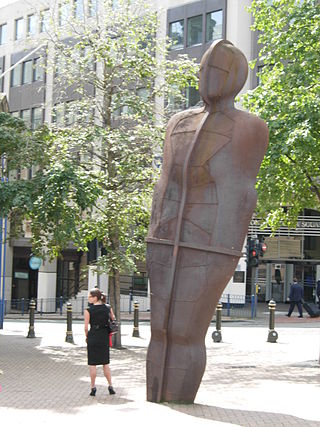
Iron:Man is a statue by Antony Gormley, in Victoria Square, Birmingham, England. The statue is 6 metres (20 ft) tall, including the feet which are buried beneath the pavement, and weighs 6 metric tons. The statue leans 7.5° backwards and 5° to its left. It is said by the sculptor to represent the traditional skills of Birmingham and the Black Country practised during the Industrial Revolution.

Willow Man is a large outdoor sculpture by Serena de la Hey. It is in a field to the west of the M5 motorway, near Bridgwater in Somerset, South West England, near to the Bristol to Exeter railway line and south of junction 23 of the motorway. It stands 40 feet (12 m), with a 16-foot (5 m) arm span, and is made of black maul willow withies woven over a 3-tonne steel frame.
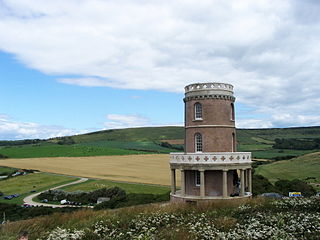
Clavell Tower, also known as Clavell Folly or the Kimmeridge Tower, is a Grade II listed Tuscan style tower built in 1830. It lies on the Jurassic Coast, on the top of Hen Cliff just east of Kimmeridge Bay in the Isle of Purbeck in Dorset, England. It is now a Landmark Trust property and in August 2006 was moved 25 metres (82 ft) back from the crumbling cliff edge.
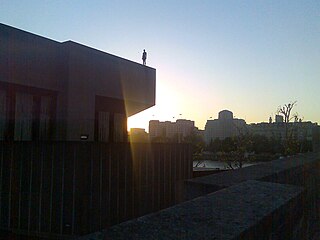
Event Horizon is the name of a large-scale public sculpture installation by the British artist Antony Gormley. First displayed in London in 2007, they were later displayed in New York, downtown São Paulo and Rio de Janeiro, Brazil. Gormley describes his statues as "...showing solitary figures installed in groups yet retaining their sense of solitude and reflection."

Leeds Art Gallery in Leeds, West Yorkshire, England, is a gallery, part of the Leeds Museums & Galleries group, whose collection of 20th-century British Art was designated by the British government in 1997 as a collection "of national importance". Its collection also includes 19th-century and earlier art works. It is a grade II listed building owned and administered by Leeds City Council, linked on the West to Leeds Central Library and on the East via a bridge to the Henry Moore Institute with which it shares some sculptures. A Henry Moore sculpture, Reclining Woman: Elbow (1981), stands in front of the entrance. The entrance hall contains Leeds' oldest civic sculpture, a 1712 marble statue of Queen Anne.
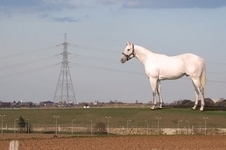
The White Horse at Ebbsfleet, formerly the Ebbsfleet Landmark, colloquially the Angel of the South, was a planned white horse statue to be built in the Ebbsfleet Valley in Kent, England. Designed by Mark Wallinger to faithfully resemble a thoroughbred horse, but at 33 times life size, the colossal sculpture was to be 50 metres (160 ft) high.
Brick Man was an Antony Gormley sculpture proposed in the 1980s for the city of Leeds, West Yorkshire, England.
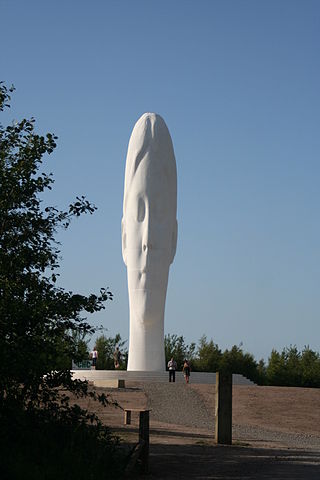
Dream is a 2009 sculpture and a piece of public art by Jaume Plensa in Sutton, St Helens, Merseyside. Costing approximately £1.8m, it was funded through The Big Art Project in coordination with the Arts Council England, The Art Fund and Channel 4.

The ArcelorMittal Orbit is a 114.5-metre (376-foot) sculpture and observation tower in the Queen Elizabeth Olympic Park in Stratford, London. It is Britain's largest piece of public art, and is intended to be a permanent lasting legacy of London's hosting of the 2012 Summer Olympic and Paralympic Games, assisting in the post-Olympics regeneration of the Stratford area. Sited between the Olympic Stadium and the Aquatics Centre, it allows visitors to view the whole Olympic Park from two observation platforms.

The fourth plinth is the northwest plinth in Trafalgar Square in central London. It was originally intended to hold an equestrian statue of William IV, but remained empty due to lack of funds. For over 150 years, its use was debated; in 1998, the Royal Society for the encouragement of Arts, Manufactures and Commerce (RSA) commissioned three contemporary sculptures to be displayed temporarily on the plinth. Shortly afterwards, Chris Smith, Secretary of State for Culture, Media and Sport, commissioned Sir John Mortimer to seek opinions from public art commissioners, critics and members of the public as to its future. Mortimer's final report recommended that there continue to be a rolling programme of commissioned temporary artworks rather than settle permanently on one figure or idea.

The Meeting Place is a 9-metre-high (30 ft), 20-tonne (20-long-ton) bronze sculpture that stands at the south end of the upper level of St Pancras railway station. Designed by the British artist Paul Day and unveiled in 2007, it is intended to evoke the romance of travel through the depiction of a couple locked in an amorous embrace.

Stay are identical cast iron human form sculptures made by Antony Gormley and installed in two locations in the central city of Christchurch, New Zealand. The first sculpture was installed in the Avon River in September 2015. The second in the Northern Quadrangle of the Christchurch Arts Centre was unveiled on 1 October 2016.

The Rush of Green, also known as Pan or The Bowater House Group, was the last sculpture completed by Jacob Epstein before his death at his home in Hyde Park Gate on 19 August 1959. The sculpture group includes a long-limbed family – father, mother, son and dog – rushing towards Hyde Park, encouraged by the Greek god Pan playing his pipes. It was cast in bronze posthumously and installed in 1961 on a plinth separating the carriageways of Edinburgh Gate beneath Bowater House. The sculpture was removed when Bowater House was demolished in 2006 and reinstalled near the building which replaced it, One Hyde Park, in 2010. The sculpture was granted Grade II listed status in January 2016, giving it legal protection against unauthorised alteration or removal.
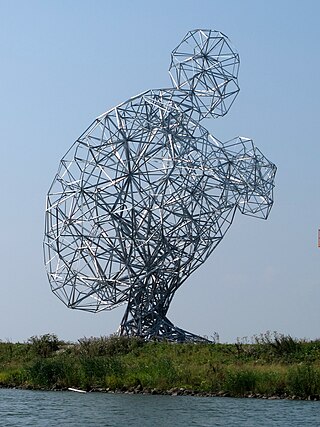
Exposure (Exposure) is a steel frame sculpture on the Markerstrekdam near the Houtribsluizen in Lelystad Netherlands by artist Antony Gormley. The work is also known as Crouching man, or popularly called the Shitting Man.




























